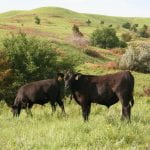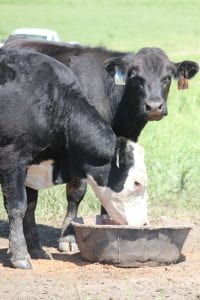MANHATTAN, Kan. – Navigating the unknown for the stocker operator and fueling performance from the inside out are among topics planned for the 2025 Kansas State University Beef Stocker Field Day on Thursday, Sept. 25. The conference will take place at the KSU Beef Stocker Unit. Continue reading “26th Annual K-State Beef Stocker Field Day scheduled for Sept. 25”
Tag: stocker cattle
Save the Date: 25th Annual Stocker Field Day Sept. 26th
Beef cattle outlook, coccidiosis, beef on dairy opportunities and challenges, pasture burning and the first 30 days on feed are among topics planned for 2024 Kansas State University Beef Stocker Field Day on Thursday, Sept. 26. The conference will be hosted at the KSU Beef Stocker Unit. Continue reading “Save the Date: 25th Annual Stocker Field Day Sept. 26th”
Long-Term Effects of April, August, or October Prescribed Fire on Yearling Stocker Cattle Performance and Native Rangeland Plant Composition in the Kansas Flint Hills
Objective: The objective of our experiment was to determine if prescribed fire applied in April, August, or October influenced stocker growth performance or plant community characteristics in the Kansas Flint Hills over a 6-year period. Continue reading “Long-Term Effects of April, August, or October Prescribed Fire on Yearling Stocker Cattle Performance and Native Rangeland Plant Composition in the Kansas Flint Hills”
2023 K-State Beef Stocker Field Day scheduled for Sept. 28
 MANHATTAN, Kan. – Beef cattle outlook, latest research into top pharmaceutical technologies yielding the highest economic return in stocker cattle and fine-tuning bunk calls in the grow yard are among topics planned for 2023 Kansas State University Beef Stocker Field Day on Thursday, Sept. 28. The conference will be hosted at the KSU Beef Stocker Unit. Continue reading “2023 K-State Beef Stocker Field Day scheduled for Sept. 28”
MANHATTAN, Kan. – Beef cattle outlook, latest research into top pharmaceutical technologies yielding the highest economic return in stocker cattle and fine-tuning bunk calls in the grow yard are among topics planned for 2023 Kansas State University Beef Stocker Field Day on Thursday, Sept. 28. The conference will be hosted at the KSU Beef Stocker Unit. Continue reading “2023 K-State Beef Stocker Field Day scheduled for Sept. 28”
Supplementation of Dried Distillers Grains to Yearling Heifers Grazing Native Range: A Potential Management Strategy During Drought
Jason Warner, extension cow-calf specialist and Dale Blasi, stocker, forages, nutrition and management specialist
Maintaining the delicate balance of cattle performance and rangeland health is part of the overall goal of managers each year. It becomes easier for these two components to become imbalanced during drought, with several consecutive years of overgrazing contributing to long-term negative consequences on rangeland productivity. While conditions certainly vary, much of the major beef cattle production areas of the central U.S. are in some degree of drought to start the 2023 growing season. Can strategic supplementation of a protein and energy source such as dried distillers grains plus solubles (DDGS) to cattle on grass mitigate the potential negative impacts of grazing in years following drought? Continue reading “Supplementation of Dried Distillers Grains to Yearling Heifers Grazing Native Range: A Potential Management Strategy During Drought”
Thoughts on Going to Grass in 2023
Dale Blasi, Stocker, Forages, Nutrition and Management specialist and Justin Waggoner, Beef Systems Specialist, Garden City
 As the 2023 grazing season approaches, stocker operators might consider various strategies to protect their risks against the market and drought conditions.
As the 2023 grazing season approaches, stocker operators might consider various strategies to protect their risks against the market and drought conditions.
If not already accomplished, producers are making their cattle purchase decisions for their intended pasturing needs. Based on historical stocking rates and the need to adjust according to existing pasture conditions from drought, producers will attempt to purchase the number as well as the size and type of the calf that can be “bought for the money.”
- Pre-grass feeding strategy considerations
Producers who already have purchased calves for grass are either backgrounding calves in a holding pattern or minimally managing them on dormant winter grass in anticipation of the opportunity to exploit compensatory gain that can be realized when cattle are placed on actively growing native pastures in April or early May.
A research trial (Anglin et al., 2008) was conducted in 2007 at the KSU Beef Stocker Unit to evaluate the long-term effects of limit feeding on subsequent performance on native pasture. The takeaway from this trial was that limit-feeding 2.25% in the dry lot before going to grass decreased feed costs. Calves that were limit fed experienced higher daily gains during the subsequent grazing period at a lower cost per pound of gain. Calves limit-fed during the background phase gained 15 pounds more than the free-choice-fed steers.
- Know the variation in weight of your calves going to grass
There may be a 250 to 300 pounds range in the lightest to the heaviest calf in a set of calves going to grass. Under the prospects of rapidly diminishing forage production from drought, producers could consider pulling the heavier calves from the grass at midseason and going either to market or beating the rush of calves headed to feed yards. Over the years, KSU has evaluated this practice (Owensby et al., 2008; Harmoney and Jaeger, 2011 and 2015) and have concluded that this modification of intensive early stocking improves flexibility for drought conditions. If producers have the capability to individually weigh animals; identifying the heaviest cattle within a group (different tag color) prior to turnout will make gathering and removing these cattle from pastures considerably easier.
- Feed and mineral inputs are exceptionally expensive this year; be prudent with their use
The consumption of self-fed mineral supplements should be closely monitored. Excessive consumption is often the result of the animal’s desire for additional salt. For example, if a complete mineral supplement costs around $500 with a labeled consumption of 4 ounces/head/day over 90 days, this calculated cost is about 5.63 dollars per head with no labor for pasture delivery included. If mineral consumption is excessive (6 ounces rather than the bag recommendation of 4), the actual cost will be $8.45/head.
If the value of gain is less than the cost of implementing a mineral supplementation program, producers may opt to provide only salt blocks. Previous research (Weibert et al., 2018) showed a reduction of daily gain of .1/lb/day when providing salt blocks vs. a complete mineral.
22nd K-State Beef Stocker Field Day scheduled for Sept. 30
A look at the future and latest research highlight this year’s agenda
MANHATTAN, Kan. – What has worked and what to see in the future, beef cattle outlook, starting newly arrived calves on feed, and the comparison of multiple castration methods in stocker cattle are among topics planned for the 2021 Kansas State University Beef Stocker Field Day on Thursday, Sept. 30. Continue reading “22nd K-State Beef Stocker Field Day scheduled for Sept. 30”
Evaluating Stocker Steer Gains on Tallgrass Native Range with Two Burn Dates and Spices in Mineral
 Objective: The overall objective of this study was to evaluate management practices that may impact stocker steer gains on a 90-day double stocking grazing system in tallgrass native range. Specific objectives include evaluating the timing of burning, addition of spices in a complete free-choice mineral, and determination if the effects are additive.
Objective: The overall objective of this study was to evaluate management practices that may impact stocker steer gains on a 90-day double stocking grazing system in tallgrass native range. Specific objectives include evaluating the timing of burning, addition of spices in a complete free-choice mineral, and determination if the effects are additive.
Study Description: Two pasture burning times (March or April) and free-choice mineral with or without addition of spices were evaluated using 281 head of stocker steers on eight pastures of tallgrass native range. The spices included garlic oil in powder form and Solace (Wildcat Feeds LLC). Continue reading “Evaluating Stocker Steer Gains on Tallgrass Native Range with Two Burn Dates and Spices in Mineral”
Effects of Limit Feeding Cold Stressed Growing Calves in the Morning Versus the Evening, as well as Bunk Line Sharing on Performance
Objective: To determine the response of cold stressed growing calves to being fed in the evening instead of morning hours, as well as the effect of bunk line sharing.
Study Description: Crossbred steers (n = 360) of Texas, Oklahoma, and Idaho origin were blocked by weight into four size groups and randomly assigned to pens, which were randomly allocated to one of five treatments. Continue reading “Effects of Limit Feeding Cold Stressed Growing Calves in the Morning Versus the Evening, as well as Bunk Line Sharing on Performance”
Evaluation of Two Implants for Steers on Early-Intensively Grazed Tallgrass Native Range
Objective: To evaluate the effect of two implants that have different lengths of effective use on stocker cattle gains within an intensive early double-stocked native tallgrass prairie grazing system
Study description: Stocker steers (n = 281) were implanted with Revalor-G (Merck Animal Health, Madison, NJ) or Synovex One Grass (Zoetis, Inc., Kalamazoo, MI) and grazed on tallgrass native range for 90 days during the summer. The steers were individually weighed, after an overnight shrink, on the day of implanting, at midpoint of grazing, and the end of the grazing period. Total gains and average daily gain were evaluated. Continue reading “Evaluation of Two Implants for Steers on Early-Intensively Grazed Tallgrass Native Range”